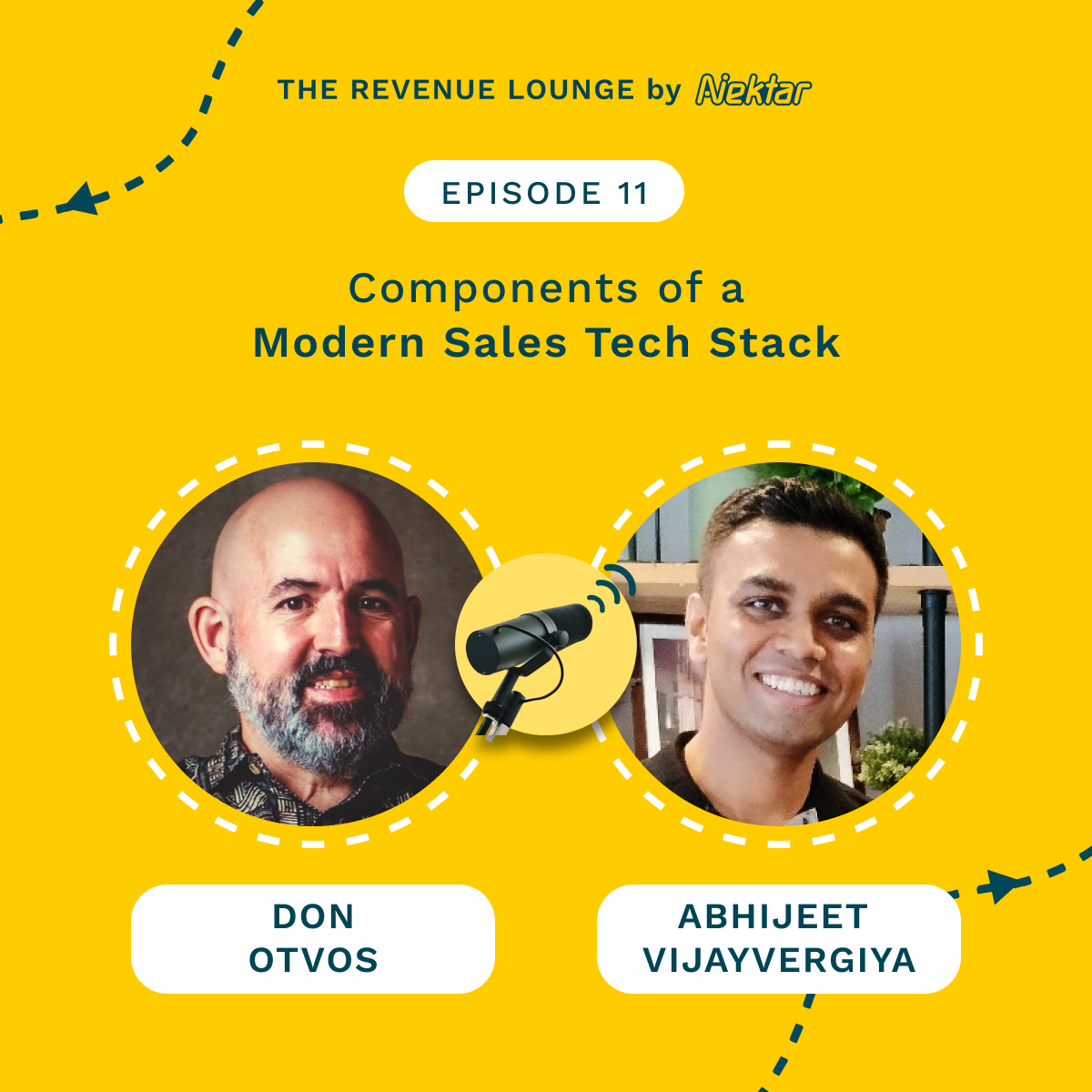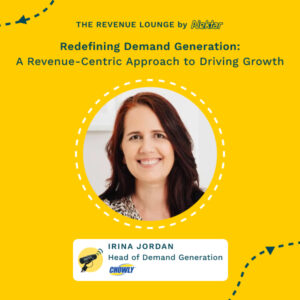Ep #1: Navigating the Downturn with a Hyperfocus on Productivity
September 13, 2022
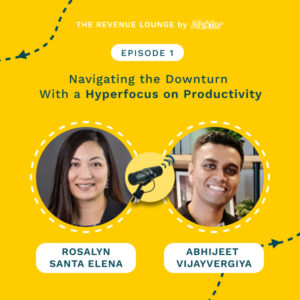
About
The Revenue Lounge
The podcast covers stories from leaders across RevOps, Sales, Customer Success, GTM, Data and Marketing about what drives these functions and what advice they would share with our listeners. With 3 seasons recorded, the podcast currently features 50+ enterprise leaders in the B2B SaaS domain. Tune in to hear from the best in the business
The mantra of “growth at all costs” that defined the last decade of business expansion is dead. This downturn has forced revenue leaders to look at more sustainable ways to conduct business that can withstand any turbulent tides that might arise in the future. The new mantra is achieving “productivity at all costs.”
This episode covers how this productivity can be achieved to shock-proof revenue generation for businesses. And what are the elements that are a necessary pre-requisite to successfully deploy the “productivity at all costs” mantra.
The guest for this session is Rosalyn Santa Elena. Rosalyn is an advisor to several high-growth start-ups on all things GTM and Operations, an active leader of Revenue operations in multiple communities and platforms, and the founder of OpsTherapy.
She is also the host of The Revenue Engine Podcast that has helped so many of us with the knowledge to elevate the ops function ourselves as ops professionals.
Want to learn more about Nektar? Talk to our team – https://bit.ly/3Sg6hWO

Abhijeet – In today’s episode, we’ll talk about a very relevant topic that’s impacting so many businesses right now. The economy is currently undergoing one of the most challenging downturns. We are seeing massive layoffs, um, investors, skepticism, and other cost cutting initiatives across the tech industry.
Most disruptions have hit businesses in the form of great resignation to start with. Then when you look at digital buying, global inflation and the whole supply chain disruption, it’s obviously got us into a downward spiral. The mantra of “growth at all costs” which most companies were living by until 2021, I think it’s a thing of the past. What most businesses are now focusing towards is how we can enter the era of productivity at all costs. And that’s where RevOps becomes important. Productivity is at the root of RevOps and the kind of specific position RevOps enjoys with respect to connecting data, systems processes and people, I think it’s in a unique position in an organization to drive this productivity up.
So in today’s episode, we are going to talk more about how this productivity can be unlocked to shock proof revenue generation for businesses. And what are the elements that are a necessary prerequisite to successfully undertake this productivity at all cost mantra. And joining us for this session today is one of my favourite people, one of the most prominent RevOps leaders, Rosalyn Santa Elena.
Rosalyn is an advisor to several high growth startups on all things, GTM and operations. An active leader of revenue operations in multiple communities and platforms and the founder of Ops Therapy. She’s also the host of The Revenue Engine podcast that has helped so many of us with the knowledge to elevate the ops function ourselves as rev ops professionals, Rosalyn. Welcome, and thank you so much for spending time with us today. So very excited to talk with you.
Rosalyn – Thank you for having me. I’m super excited to be here. And of course, always happy to talk about my favourite topic.
Abhijeet – Yeah, we are excited and I think our audience is excited. So let’s get to get started. My first question for you today is as we look at the downturn, right? It’s hit us hard. So we are continuously reading about how investors are advising founders to manage their cash burn. I think burn multiple is an important metric everybody’s looking at us. Budget slashes are happening. Unfortunately, layoffs are making headlines every passing day.
I think companies are focusing on creating at least a two year runway or, or more so as a revenue leader yourself. Right. What are the immediate challenges that you have seen CROs face in these difficult times?
Rosalyn – Yeah. That’s a great question. I think at all times we should always be looking at cash burn, right? Watching our budget, you know, doing all of the right things all along. The last couple of years have just been insane, right. The market and the world has been crazy for everybody. So I think being really prepared for that is really important.
But in terms of sort of some of the challenges, I think that other revenue leaders are seeing, I mean, revenue is going to slow down, right? Regardless, it’s going to slow down. What do you do to prepare, right? How do you go on what I would say, go on the offensive, right. And start to tackle that. And this is something that I would really encourage everyone to always be thinking about, right. Not just in, okay. Now we’re in reactive mode.
We should always be proactively looking at these things. Things like how do you get your revenue to be more predictable. How do I, you know, my forecasting, my pipeline, all the things around making your revenue strong, predictable, and accurate are always going to be important, but especially in a downturn market. You touched on this a little bit, but around doing more with less. Really figuring out how to be more efficient and more effective. And I know we’ll probably talk about productivity a lot today too. But I do think there’s an element of productivity that’s really important, but it should still be very focused on outcomes, right. Because we want to do more with less. We want to figure out how to be more effective and more efficient and drive those outcomes that we’re expecting.
I think one of the challenges that we saw two years ago and similarly now is really doubling down on your ICP, really looking at your customer, really understanding what’s working and what’s not. So the immediate challenges of course are yes, budget cuts. Everyone’s trying to do more with less. So that’s kind of a perfect segway right into the revenue operations discussion.
Abhijeet – Yes, indeed. Staying proactive is very important. Otherwise there is a big risk for businesses ahead. There are a lot of knee jerk reactions are happening. Some of these could have been avoided if there’s a proactivity at a strategic level and like execution, but yeah, I think there’s more that can be done.
And there’s a big learning out there for everyone to follow and be very proactive with some of these initiatives that you spoke about, which brings me to the next point. I think if you look at the whole of the last decade, since we saw the whole growth of venture funds, once the startup raises money, it’s like a treadmill, right?
You’re onto it. And there’s an expiry date return on the startup road. So you have to grow in that timeframe and grow bigger, sooner, faster. So growth at all cost mindset takes shape when it comes to building businesses. Now that has completely changed, right? The same VCs are now advising startups to focus on productivity, focus on their runway, focus on their burn, multiple and what not.
So now backed by significant budgets, while it was easier for companies to buy different tools, hire different types of people, throw money at the problem – now with the downturn, all of these budgets are out, right? And teams are getting leaner and extra tools from the tech stacks are getting eliminated tools, which basically are solving must have problems which are essential need are staying.
And I think everything else is getting chopped off. So this is increase in operational efficiency, to some extent, maybe fixing some of the product free leakage, but do you think this is what all it would take? While these are immediate cost cutting measures, but are these sustainable? What do you think about it?
Rosalyn – Yeah, I think, you know, having going through this downturn again just highlights the same problems that people have within the organizations. And similarly, to always looking at how to do more with less and be more efficient and effective, I think from a tech stack perspective, you should always be looking at how do you optimize your tech stack.
Really make sure that you don’t build this, what I call the Frankenstack. Right. You don’t start to just buy all kinds of shiny new tools to build something that you think you need. It’s like, oh, I have this problem. So I’ll buy a tool. But being thoughtful, especially now.
You know, all the time, you should be doing this, but especially now you should be taking a look at your tech stack, mapping it out. I literally have a roadmap of all the technology and what is, you know, aligning it to the customer journey and thinking about for every single piece of tech. What is the use case? What is the business challenge that you’re trying to solve with that piece of technology? And you should always be looking and making sure that you’re aligning that tech stack to a very specific set of use cases that solve your customer’s problems. And always looking at measuring that ROI, making sure you’re getting value from the technology and that getting that value.
Not just aligning to the business cases, but also through adoption and through making sure that the team’s actually using the tools. Because I think a lot of us will buy something. They’ll implement it. Shiny new object. Think that it’s great. Everybody’s happy about it. And then, you know, three months later nobody’s been maintaining it or driving that adoption or assessing the value.
And what happens is then that tool becomes stale, people are like, oh, it doesn’t work for me anymore. I need to go buy something else. And that’s how that Frankenstack sort of begins, but really taking a look at, you know, figuring out what do you really need because technology can help with productivity and it can help with operational efficiency, but only if you have the right technology for your business and you are leveraging that technology.
So this is the perfect time to really take a hard look at all of the tools that you have and making sure that you’re optimizing that tech stack.
Abhijeet – Yeah, definitely. I think a great point there as we were discussing earlier, right? I mean until 2021 where there’s free money flowing, I don’t think anybody thought twice before buying the next shiny tool that came their way or the next investor introduction that happened to get that tool onboarded. But now I think it’s the right time to make all of that efficient. I did quite like the point that you made around looking deeper at your tech stack, probably doing a full audit.
I think what stood out with me is identifying the right use case that you mentioned and connecting it with your customer’s problems, I mean, not just your problem in the business already solving, but what you’re solving for your customer as a business. So if the tool is a step towards enabling that, I think that’s a tool that should, that should stay.
And in the second point that you mentioned also around enablement, how do you get adoption going. Big pain point for businesses. And I think it’s a great opportunity to look at what’s necessary and invest in doubling down on it with respect to driving adoption, so that productivity can be unlocked.
Because tools are good. I think that a lot of these tech solutions are built with some use case or intent in mind. It’s important for businesses to identify whether that use case is relevant to their business. So you made a great point.
Rosalyn – Yeah. I definitely think relevant to your business and then continuing to educate your team. So that they are unlocking the real value from the technology. People always ask me like, oh, what’s the ideal tech stack, you know, what should I buy and everything. And I always think about mapping that to your customer journey also. Right? How does your buyer or your prospect like to be engaged?
Right? That interaction with them. And at the top of the funnel, if you think about even figuring out who your prospects are, right, who is your ICP and who’s your target customer, and that’s where sort of the data and the analytics and such, you know, obviously come in and you want to buy the right technology there as well.
It’s really important versus buying what everybody else is buying, because it sounds great. You know, it’s the most popular brand. They have a great brand. We just go buy it, but it may not solve for your use case or be right for your business.
Abhijeet – Yeah, great point there in terms of mapping the customer journey, I think very few organizations do that. It’s so surprising. It’s very intuitive and like probably a 1-1, but a lot of organizations don’t look at defining their customer journey, mapping it, and then probably constructing the tech stack. I mean, tools get poured in much earlier in the journey, even before somebody has written down that customer journey map. So I think a great point to drive home. I think what you mentioned there, it should be in line with your customer journey.
So moving on to the next question and bringing us to the topic of the conversation today, right? How important do you think this mantra of productivity at all cost is? Is it a goal that can stand the test of times and not just like a goal to have now because the market is. What do you reckon there?
Rosalyn – I think productivity at all costs is relevant, but I think it, my experience has been that causes some strange behavior, right? I think it just causes some weird behavior because then we get really focused on activities and actions and measuring the wrong things. Potentially, you know, instead of looking at number of calls or number of meetings, those are all early indicators to something, you know, to an outcome that, that the business is driving towards. Right. They’re early indicators, but they’re not the end all be all right. I think really focused in on outcomes.
Like we were talking about a little bit earlier, really focused on outcomes, you know, revenue, everybody wants more revenue faster, right? So shorter deal cycles and bigger. At the end of the day, that’s what we want. And we want to retain customers, especially in this SaaS model. We want to continue to expand within our customer base and have them renew and be happy.
And so if you think about everything related to the actions that will drive those outcomes is much more important, I think, than just saying productivity, right. Productivity comes with, you know, obviously efficiencies being more effective, right? Those are sort of the underlying attributes of being product.
So I think focusing on being efficient and effective in driving those outcomes is much more important. And, you know, to answer your question around kind of stand the test of time. Absolutely. Right. I think that that’s super important be, but we should, again, [always be thinking about that. And that might just because I have a ops hat on all the time that I’m always thinking about how do we make things more efficient, right.
How do I help the team be more effective, do more with less right. Less calls. Generating, you know, to the right people, with the right messaging, with the right information and the right value to be able to actually close deals faster. I think that’s, you know, that’s kind of the, the ultimate goal for everybody.
And I think that’s the really, what’s really important to focus in on versus just being productive.
Abhijeet – Yeah. Well, I think that’s more holistic as you pointed out. So moving on to the role of rev op. Right. I think we discussed some of the goals. We discussed some of the challenges. How do you think RevOps can step up in today’s market. And how can they ensure the automation gets supported in these difficult times?
Rosalyn – Yeah, I think, I mean, perfect segue into RevOps, right? I’ll try to stay off my soapbox a little bit, but I probably will get on it for a bit, but I mean, if you think about like who better right than revenue operations to highlight all of these things, like I said, my hat’s always on op, so I’m always thinking about that. Whether we’re in a downturn or, you know, a market that’s just high. Right at all times, there’s always ways to be doing things. and I think even if things are working really well, there’s always ways to improve.
And I think operations is always looking at that. Um, ops plays a really key role here, especially if you think about, you know, two years ago, when the pandemic hit, you know, you always use this example because you think about in January, you know, everybody had their kickoff meetings. Everybody had their goals or strategy.
There were you know, everybody was super excited. February comes around March pandemic hits. Everyone had to reach shuffle. Right. They had to scramble figure out what does this mean to them? How does this change their targets? How does it change their, you know, who they sell to their selling motion?
They had to review everything. So I think it really highlighted that the organizations that had a really strong revenue, operations infrastructure. Those are the ones that were able to quickly assess, right? Because they had the strong infrastructure, the strong data, the insights, the information to be able to quickly assess what’s working.
What’s not be able to pivot or be able to lean in, figure out what they should be doing differently. And then it’s kind of swivel chair and then go and execute, right. Cause operations also, you know, if you decide to change your targets, that means new quotas, new territories, new cop structures, right. All of that has to happen as well.
And so operations really plays a key part in that, not just from a strategic lens of figuring. What changes need to be made, but then from a tactical and practical perspective of actually executing those changes from a people process and technology perspective, and particularly in a downturn, rev is extremely important and you have to have the right.
Revops structure, because they’re the ones who are going to be able to see those blind spots. Right. They’re the ones who are able to see around the corners and what’s happening and be able to test different types of assumptions or hypotheses and be able to figure out what’s the most likely outcome.
Abhijeet – Yeah. But definitely I think RevOps has that unique vantage point, right. I think from where. They have this picture that’s available to them. But I think one thing that I’ve heard from a lot of RevOps folks who we have spoken with is about this whole journey from moving from tactical role to like a strategic role or getting that seat at the table.
Right. I mean, not a lot of organizations have given the seat to RevOps at that GTM table. If you may call it. So, how now do you think RevOps can actually step up what would be your maybe tip or tips to our audience there or rev ops practitioners, how they can use this opportunity to grow from a tactical role to a strategy role and help their organizations.
Rosalyn – Yeah. That’s a great question. I think that I probably get asked that one quite a bit. That’s probably one of the top, I would say probably top five questions. The other was, are always like, where should we report to, you know, what should I hire for first? Right. We always get those kind of types of questions, the perfect tech stack that always comes up.
But I think from our a RevOps perspective. I mean, this is a perfect time to be able to demonstrate volume, right? If I’m a practitioner in an organization now is the best time to show, Hey, all of this work that I’ve done all of this day to day, you know, building processes, building systems and the technology in order to unlock these data insights now is the perfect time to high.
The work that’s been done, be able to bring those insights and don’t run a report. You know, this is always my tip. Don’t run a report and email it over or send a spreadsheet. Don’t do that. Right. Take the information, take the time. Really understand the business, really digest. What is the data telling me?
What are the stories behind that data? Be able to bring those stories to your executive team with a proposal, right. Be the business owner, look at the data and say, okay, based on what I’m seeing in the data, here’s where we should pivot. Right. These are my recommendations. Here’s what I’m seeing is, you know, Hey, it’s not really effective.
We should do less of that. Let’s test a, B and C, right. And come with a perspective. Right. Come with a recommendation based upon data. And you have the data in your back pocket to share. Right. But come with that story. And the more, I think rev op does that. The more we’ll be seen as a business partner and a thought leader versus that tactical kind of order taker.
You know, somebody mentioned to me yesterday, I feel like I’m CRM police and that’s it. Right. But more, much more than that. And we can be, and I think, you know, folks ask always like, oh, how do I get a seat at the table? It’s like, well, when you get to the table, bring a story, add value, right. If you’re just going to sit at the table just to listen, then you’re not going to get invited to the table.
Come to the table, come to the discussion, have an opinion, have a perspective. And most importantly have recommendations, right? I always come to the table with, Hey, this is what I’m seeing. This is what we should be doing. And then here’s the pros and cons of doing that. Right. And then be able to offer solutions.
And then your real value, not only for bringing those thoughts to the table, but also now you are the best person also to go execute upon that and keep everybody aligned and marching to that decision. Yeah, I think the way forward is to be more consultative and don’t just go to their table and occupy that seat, reading a report, go with insights.
Abhijeet – As you pointed out, I think do that work and effort upfront to understand the business and drive key specific business. They can help your business or help different stakeholders. Great advice. They’re very, very practical and functional in today’s market, especially, and a great opportunity for DevOps teams to grow into that strategic partner they always wanted to grow into.
I think it brings me to the next point around. So cross-functional visibility. One of the things that we are noticed are data silos, right? That are there, especially in a B2B size business, when you just don’t have a funnel, you have a bow tie from a lead to cash perspective. You just don’t have to land the account, you to also expand them.
And then you have this revenue supply chain kind of thing that gets created. So there’s so much of data leakage or productivity leakage, revenue leakage that happens through this bow time model. so how important do you think visibility is here? How rev can drive that visibility to make sure that this data leakage or productivity leakage is stopped and we’re able to drive efficiency or productivity across this revenue supply chain?
Rosalyn – Yeah, I think that’s a primary area of responsibility for revenue operations. Right? That’s one of the biggest value ads I think, is having a rev op function or a leader that can step back and see. Stick right up to your point across the entire customer journey and across the entire revenue process, because we’re not just focused on top of funnel or just focused on, you know, converting a prospect to a customer or just focused on the back end.
Right. In terms of once they are a customer and retaining them, we are somebody who’s kind of stepping back and looking at the entire journey. So it is a big role for revenue operations, because it. Bubbling up those insights, right. And that visibility to the data, you know, we talk about people, process tech and data, right?
Kind of that, all of those different components and managing that data across the entire customer journey to me is a revenue operations function. It’s part of our responsibility because not only we own process, but we own the technology and making sure that all the systems are talking to each other and then bubbling up that visibility to the right people at the right time.
You know, I talk about revenue operations a lot in the context of alignment. Visibility or transparency and then just that operational rigor. And so I overuse those words a lot. around alignment, rigor and visibility transparency, but that is what we really bring to the table. Because here as you have a party who’s solely focused on bringing that visibility to the business.
And it’s not just go to market, right? We’re bringing visibility into finance, to product, to legal, you know, where it’s necessary to HR. If it’s a people aspect, I always tell people that, you know, nobody is safe from operations. Like we will get into your business. And in earlier stage companies will even be, you know, we’ll even be talking to the engineers because we want impact on what’s happening with the product.
Abhijeet – Yeah, definitely. I think that’s the strategic value most of the rev op teams can actually deliver. And that is a clear path forward to do that. And that brings me to the next question around tech stack. I think we, we did touch upon it briefly, but I just wanted to put discussion forward to respect to the current times, right.
There are some companies that are looking to invest in sales, tech stack as well, even in the current market. But when rev op leaders evaluate the solutions in this market, what do they need to do? Is there something different that they need to do when it comes to procuring these solutions, to make sure that these are deployed and used by different functions efficiently?What do you recommend from a tech stack procurement perspective in a downturn market?
Rosalyn – Yeah. So aside from, you know, obviously looking at your understanding your process, right? Making sure you understand some of those use cases that we talked about and kind of the business challenges that you’re trying to solve aside from, I think those fundamentals before you ever purchase technology, those things you have to do.
Right. But I think in a downturn market, what’s really important that I found is making sure you have the right data. And you have the right insights, right? Those are incredibly important all the time, but especially in this type of market, because how else do you know what’s working and what’s. And being able to make sure you have the right data sources for your business.
And if you don’t, and this is what I see a lot of is organizations will have two or three data sources, but none of them are the right ones for their ICP, or they’re not using them the right way, or they don’t have a hierarchy of, you know, what’s important and what’s not. And so the data is all, um, kind of working against each other.
So having that data strategy and having really good data. is incredibly important in this market. So if you need to go get data, that would be my one thing to pay for, for sure. Is data right? Getting the right information. And then the second piece of it, I think, is having the right insights and the right analytics.
So there’s so many great tools out there that, you know, talk about AI and machine learning and all of these different things. So there’s no excuse for not having good insights, but you need to go figure out what is the right offering or solution that works for my. And making sure that you invest there, but that’s after you have obviously all the infrastructure, good process you have adoption, you have, you know, the right use cases clearly defined, but once you do, I mean, if I only had money to spend on, you know, what would I buy if I could only buy like one or two things.
And I definitely invest in getting the right data and getting the right analytics.
Abhijeet – Yeah, no bang on there. I remember Yamini at HubSpot. She mentioned in one of our LinkedIn posts about disconnected systems, leading to disconnected data, which is leading to disconnected teams. So true as well, especially in the current market where teams need to be even more connected, being more efficient and productive.
And if you at the outset, don’t have your systems connected and you don’t have the data in place. Very difficult to get. Right insights to take any of these actions. Right. Great advice again, for the rev op teams out there to look at their data, probably do a data audit and, and see how they can fix that missing or scattered data problem, which I think they face moving on to the next question, Rosalyn.
So what would be the components of a solid rRevOps strategy, which can help automations navigate these tough times a strategy that can have like a hyper focus on productivity and then can also solve the broader strategy. Of the automation. So what would you recommend rev op should include in that strategy?
Rosalyn – I think for every organization, right. Really honing in on, okay, what is my go to market motion? What’s my go to market strategy and goals, right. Those key objectives. And a lot of times it’s, you know, it’s growth, it’s retention, it’s more revenue. It’s, you know, customer happiness and things like that.
But if you really think about what’s your strategy, what are those key objectives? And then think about what are the, um, What are the metrics that matter, right? What are the metrics that are going to actually assess how we’re performing against those objectives is really important. And then the next layer is to go figure out the data, right?
You need the right data to be able to assess performance against those metrics. Right? So from a rev op perspective, always tying back to the strategy, always tying back to, you know, those metrics that matter. Is going to help you determine what’s important from a revenue operations perspective, right?
When you think about kind of that people process tech data and that whole alignment piece and driving rigor and driving visibility across those it’s should always tie back to your strategy and every company. That’s why there’s always like that never kind of one size fits all where everybody just does these five things, but fundamentally, always tying back to the goals.
And what are you trying to achieve in the next six months, 12 months, or even 36 months out and tying the rev op sort of roadmap to that. I think it’s really important. People don’t map it out, you know, people talk about, and that’s how they end up in that fire fi fighter mode. Right? Cause they’re being very reactive instead of having a roadmap of where am I trying to go and what am I trying to achieve?
Abhijeet – No, definitely a big need to come out of that reactive knee jerk mode of execution. I think you mentioned it a few times, but I can’t emphasize more as well after hearing you and talking to other rev ops leaders as well. Who’ve been on our podcast. I think time to get proactive when it comes to rev ops, moving towards the end of the conversation.
So my penultimate question here is what shape do you think the role of RevOps is going to take over the next 12 to 24 months. Obviously the number one priority is to support on managing adversities. But besides that, how do you think the role will shape out in the next two years?
Rosalyn – Yeah. I always think of, you know, revenue operations as the secret weapon.Right. I think it’s the secret weapon to revenue, you know, it’s really the key strategic differentiator right in organization over the last two years, I think in 2020, like I said, with the pandemic hitting it, highlighted the fact that Hey, companies who had really strong operational infrastructure are the ones who were able to move faster.
They were able to move much faster. The company I was at, we had a really strong operations function where, you know, March things hit reassess everything in April, may everybody had their new plans, right? New books of business, new quotas knew exactly what they needed to go do. So now we have seven months, you know, in the year to go do that.
But there were also companies who were still in September, you know, You know, three months of the year, still figuring out where do they need to go and what do they need to do? So I think that we saw that. And with 2021, then we saw the rise of rev op right. Everyone was talking about revenue operations, whether they knew what it was or not.
Right. And so there were a lot of questions around, what is this? Is this new? Where did this come from? But people have been running, go to market. You. There there’s been operational structure under the go to market team all along for as long as there’s been sales, right. It’s just starting to be a much more important aspect of any business because of the one, the complexities of the tech stack.
That’s a big one, but also just the complexity of the buyer. You know, when you think about you and I, when we go to buy things, right, we expect a certain level. Experience, right. We all want it easy. We want it frictionless. We want to be able to have a really great customer experience. So that has also. You know, lent to its way to a much more complex revenue process.
And then just the sheer amount of data and insights available has been daunting for folks. Right? So having revenue operations there to somebody who is that data governor or somebody who is looking at that across your go to market is really important. And then now in 2022, we’re starting to really see it again, right.
With the downturn. But now it’s not, as you know, everybody’s just like, okay, I know I need it. Now we have the shortage of talent. right. We have a whole another, we have another obstacle now because now we don’t have enough. Operations folks. So companies are struggling to get the right people, right? They’re looking for that, unicorn that as we call it the purple squirrel, right.
They’re looking for that really special, you know, kind of diamond in the rough rev op person, and then rev op folks are being asked to do a lot more than even before, right before they were already underwater tactically. But now they’re being asked to really up level themselves, be more strategic, start to think, and really affect the business.
And it’s a great, great opportunity. So for your audience, people who are listening, it’s like, this is the best opportunity and best time for you to up level your career, but also up level yourself in the value that you bring to the organization. And for organizations that are listening, this is the time if you haven’t invested in revenue operations, or don’t understand it, get yourself educated as quickly as possible because you’re gonna be.
Without this structure. So for rev ops, I think we’ll continue to see just the rise and the importance of revenue operations in the overall business. Not just from a revenue perspective, but from an organizational perspective, we’ll keep seeing. More and more importance in this role. I think we’ll hopefully see more investment, which we’ve already been seeing in 20, 22 lot more investment.
And, and then the people who are within these roles will continue to be able to really invest in themselves and up level themselves. Right. I think as you know, I think a couple years ago, about three years now, I’ve been sharing a lot of content and sharing information because there wasn’t a lot. Of people who are doing that.
But right now there’s tons of people doing it. There’s lots of content, lots of, you know, like this podcast that you’re doing a lot of the work that you’re doing on, you know, your, your content from Nektar and other companies are producing a lot of great information. So there’s tons of resources now for revenue operations or people who are interested in moving into rev ops and people who are thinking about investing in revenue operations.
Now’s the time to really just get educated so that you’re not left behind.
Abhijeet – Oh, awesome. It’s never too late.
Rosalyn – It’s like an infomercial.
Abhijeet – Yeah, it’s never too late. So what do you get most excited about from a future standpoint? I mean, we spoke about to next two years of rev, right? If you go fight 10 years down the line, what kind of a future that you visualize of a, of RevOps and what gets you most excited about that?
Rosalyn Yeah. So I think a lot of the things that we kind of talked about, just the rise and the understanding of revenue, operations, I think is really exciting. I think seeing more individuals step into these type of roles is really exciting. And also seeing the people who have been. Doing this for a little while being more open to sharing and mentoring and helping coach.
The next generation of operations professionals is really exciting for me. I spend a lot of time doing that myself, but to see other folks also participating because we are a really unique community, I think operations, right? We. Sellers, you know, but we really are. Cause we sell internally, right? We always have to sell value.
We have to drive adoption and such, but we’re not at least for the most part. We’re not a competitive bunch. Right. We’re much more about collaboration, which I think is really unique because we’re very, very willing to share the secret sauce right on how to do things just to help up level each other and up level the function overall.
So I’m super excited about it. I’ve been for years now and just continue to be just a huge champion of.
Abhijeet – Yeah. I mean, you indeed have been a great champion of rev ops and thanks for doing all the work you’ve been doing and thanks for being the evangelist and the poster girl for RevOps. Thank you. I think we all appreciate the work you have been doing, and it was lovely having you on the show today.
Rosalyn, I think there’s a lot of words of wisdom and lot of interesting information that was very relevant for today’s time for our audience. So thanks for sharing that. So generously, I was lovely chatting with you today, Rosalyn. Thank you again.
Rosalyn – Thank you for having me. This was fun.
Abhijeet – My pleasure.Thank you.
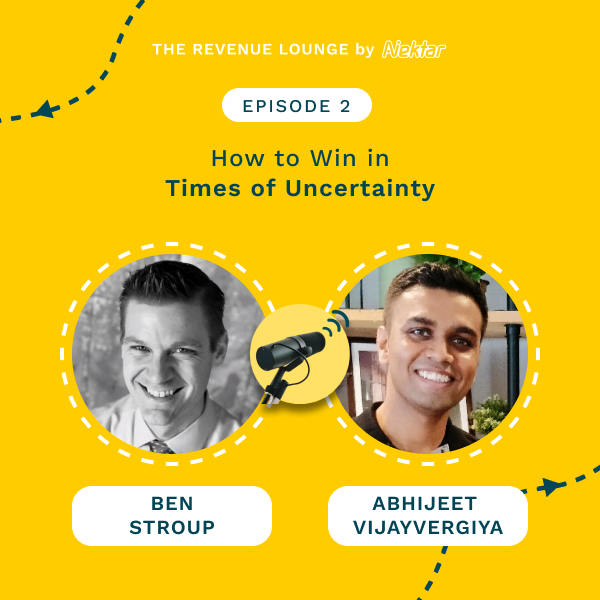
Ep #2: How to Win in Times of Uncertainty
Listen Now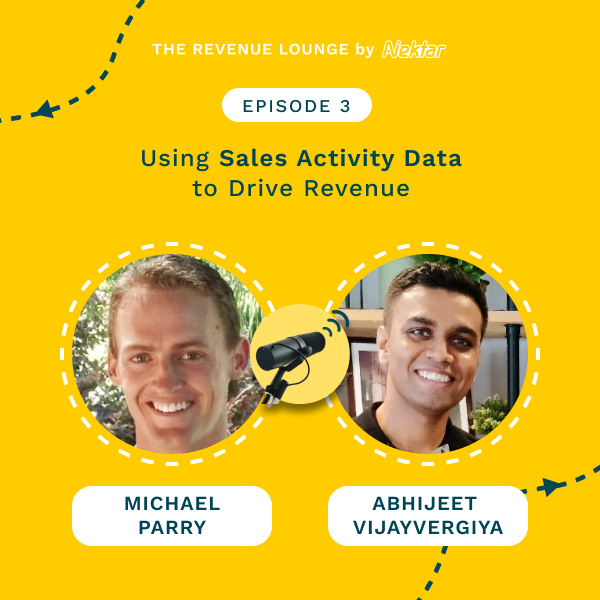
Ep #3: Using Activity Data to Drive Sales Productivity
Listen Now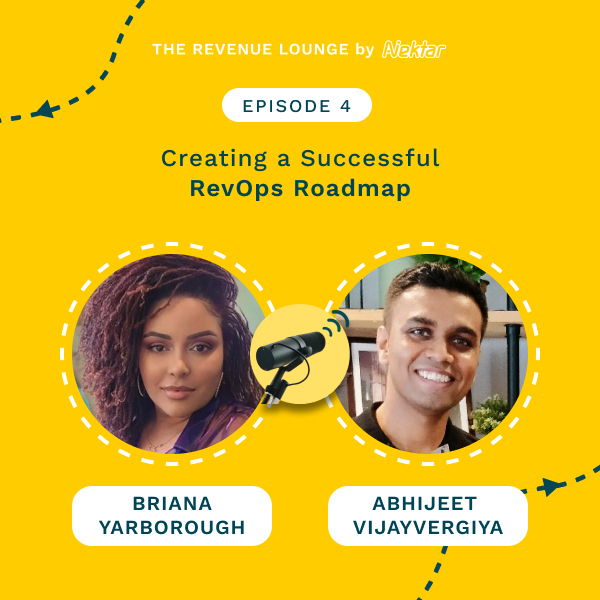
Ep #4: Creating a Successful RevOps Roadmap
Listen Now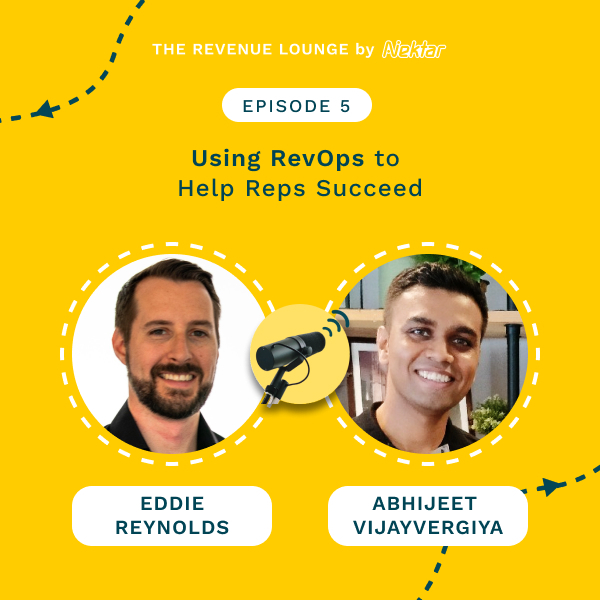
Ep #5: Using RevOps to Help Reps Succeed
Listen Now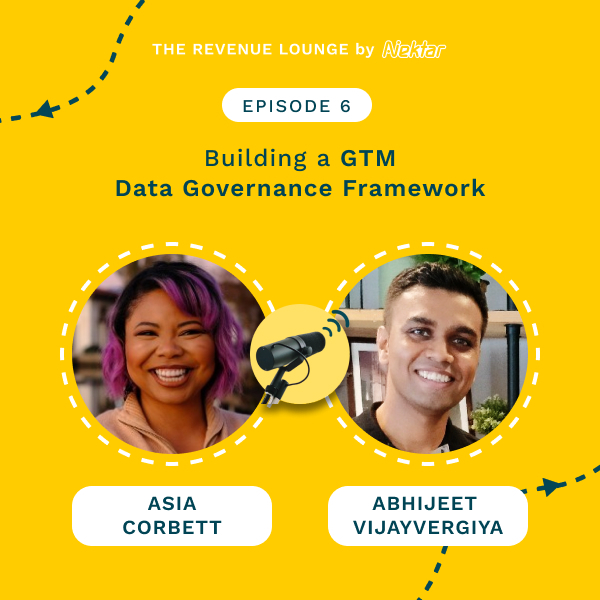
Ep #6: Building a GTM Data Governance Framework
Listen Now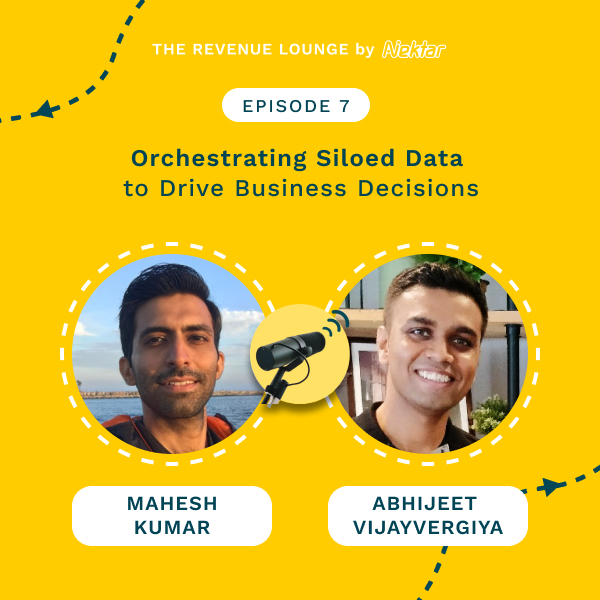
Ep #7: Orchestrating Siloed Data to Drive Business Decisions
Listen Now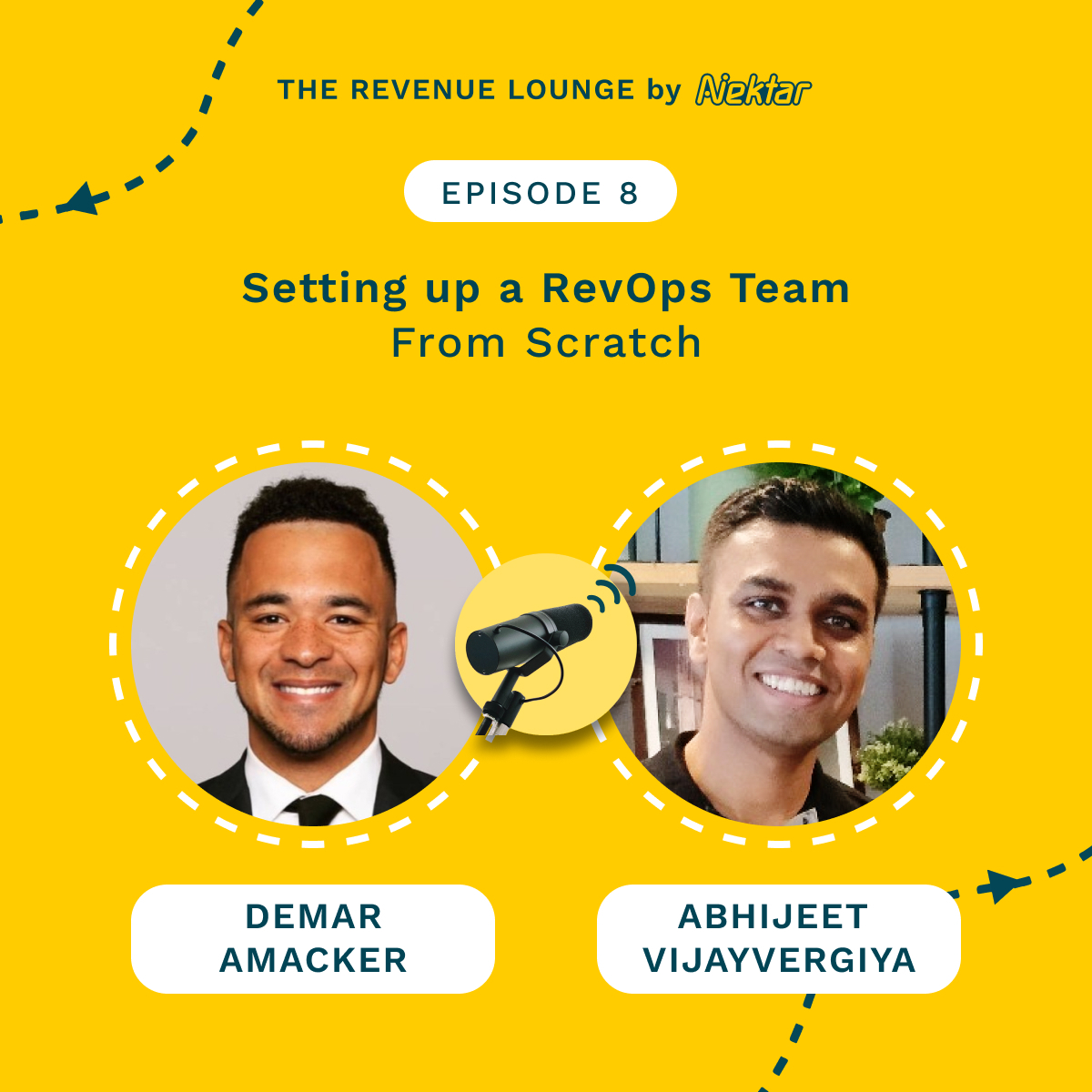
Ep #8: Setting Up a RevOps Team From Scratch
Listen Now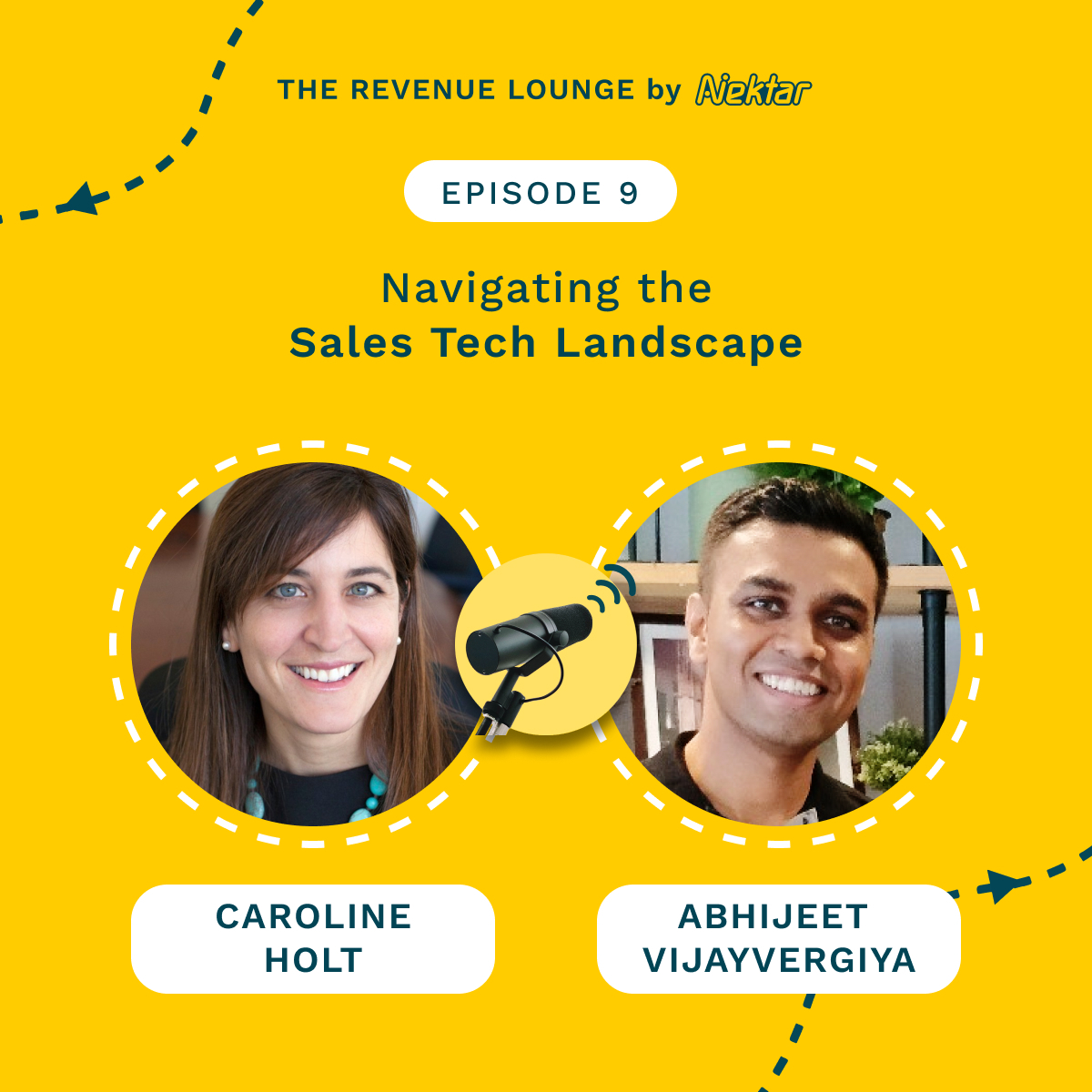
Ep #9: Navigating the Sales Tech Landscape
Listen Now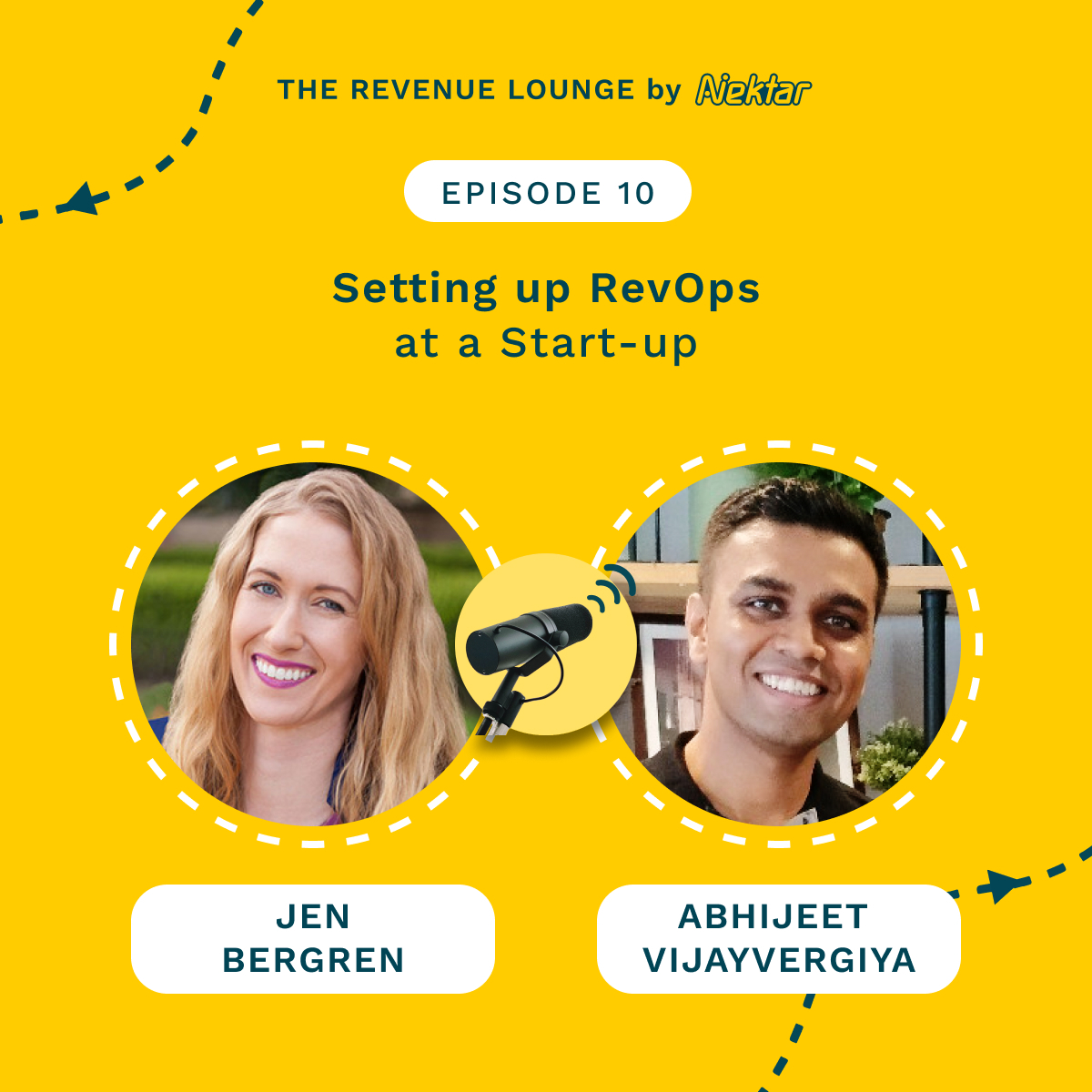
Ep #10: Setting Up RevOps at a Startup
Listen Now